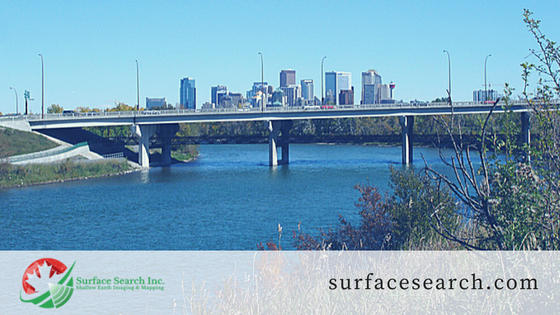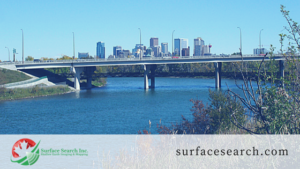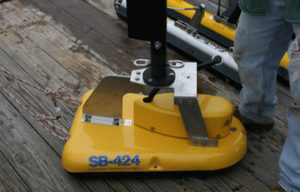[x_custom_headline type=”left” level=”h2″ looks_like=”h3″ accent=”true”]Near-surface geophysics at proposed pipeline river crossings: a comparative overview of various techniques and their associated capabilities and limitations.[/x_custom_headline]
This is part 1 of our three-part series on the application of near-surface geophysics at proposed pipeline river crossings.
Abstract
The cost, design, and in some instances, feasibility of directional drilling large diameter or lengthy pipeline river crossings is primarily dependent on ground conditions encountered during construction. Geotechnical investigations are commonly used to explore and assess subsurface conditions at proposed crossings. Ground conditions are determined using borehole drilling and near-surface geophysics. Borehole drilling provides subsurface sediment stratigraphy and depth to bedrock information. Geophysics is used to provide information between borehole locations or where borehole drilling is determined to be too difficult or too costly. When used to augment borehole results, geophysical surveys provide more complete geologic cross-section models throughout the length of a proposed directional drill path.
This paper presents an overview of the more common geophysical methodologies used to profile subsurface conditions at proposed pipeline crossings. The methods discussed include ground penetrating radar (GPR), seismic refraction profiling and electrical resistivity tomography (ERT). The appropriateness and feasibility of each method is discussed in terms relating to investigation objectives of geotechnical and pipeline design engineers.
All three methods were applied to two survey lines at a typical river crossing site on the Bow River, downstream from Calgary, Alberta. Results from the overlapping surveys are presented and the capabilities and limitations for each method compared. Borehole information obtained within the survey area is used to corroborate the interpreted geophysical results.
Introduction
Geotechnical investigations of proposed large diameter or lengthy directional drill pipeline river crossings often employ near-surface geophysical methods to explore subsurface conditions in advance of construction. Used in conjunction with exploratory borehole drilling, geophysical surveys help to provide a more complete understanding of the subsurface conditions that will likely be encountered during construction. Geophysical methods commonly used to image subsurface conditions at proposed crossings include: ground penetrating radar (GPR), refraction seismics and electrical resistivity tomography (ERT). Used alone, or in tandem, these techniques represent a non-intrusive, environmentally friendly means of obtaining subsurface information desired by geotechnical and pipeline design engineers in the feasibility and design stages of a directional drill project.
The primary advantage of using geophysics as part of geotechnical investigations for proposed pipeline river crossings is that subsurface information can be obtained throughout the length of a proposed directional drill path route. Geophysical surveys are capable of providing subsurface information in-between exploratory borehole locations as well as in areas where borehole rig access is either restricted (e.g. environmentally sensitive areas), or prohibitively expensive (e.g. over rugged terrain, or difficult to access areas). Geophysical surveys in themselves however cannot be considered as a replacement to exploratory borehole drilling. Borehole data are necessary to substantiate and calibrate the geophysical results. When applied properly, and when in compliment with borehole drilling, interpreted geophysical survey results can be used to create geologic cross-section models representing ground conditions throughout the length of a proposed directional drill path.
This paper discusses the various geophysical methods that can be used to image and profile subsurface conditions throughout the length of a proposed pipeline crossing. We overview the capabilities and limitations for each of the methods presented herein: GPR, refraction seismics and ERT. Results from overlapping geophysical surveys conducted in the valley bottom of the Bow River downstream from Calgary, Alberta are presented to illustrate the capabilities of each method to resolve subsurface features pertinent to geotechnical investigations of proposed river crossings.
[x_callout type=”left” title=”Looking for a Solution?” message=”A comprehensive understanding of what lies beneath the surface within the confines of your project area matters. Encountering unforeseen subsurface features can be detrimental to your overall project budget and completion schedule.” button_text=”Contact Us Now” button_icon=”phone-square” href=”https://surfacesearch.com/contact-2/”]



